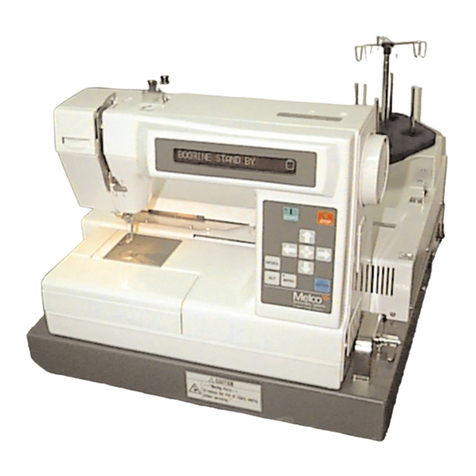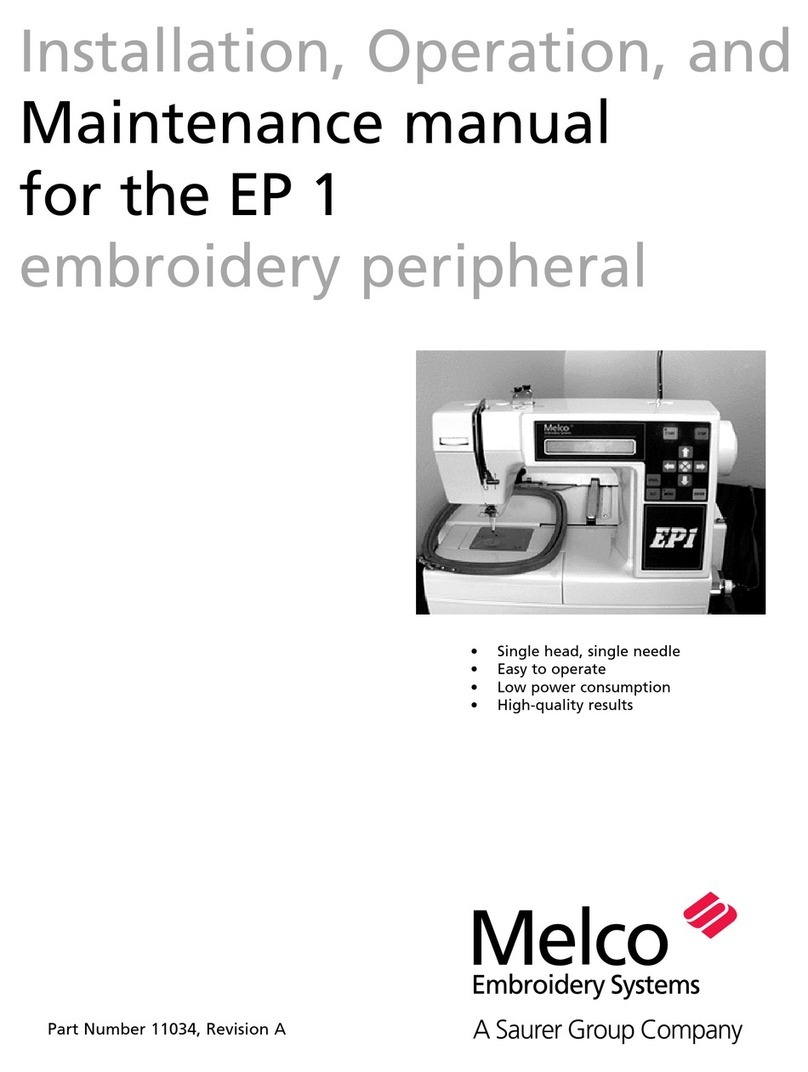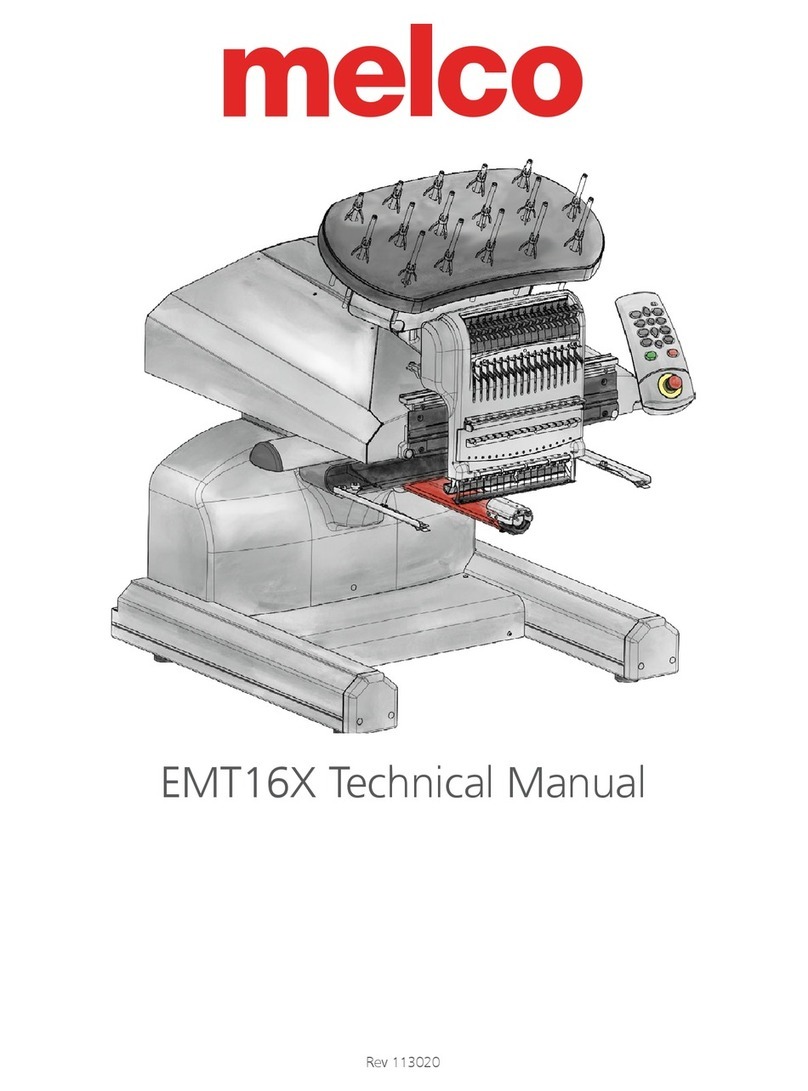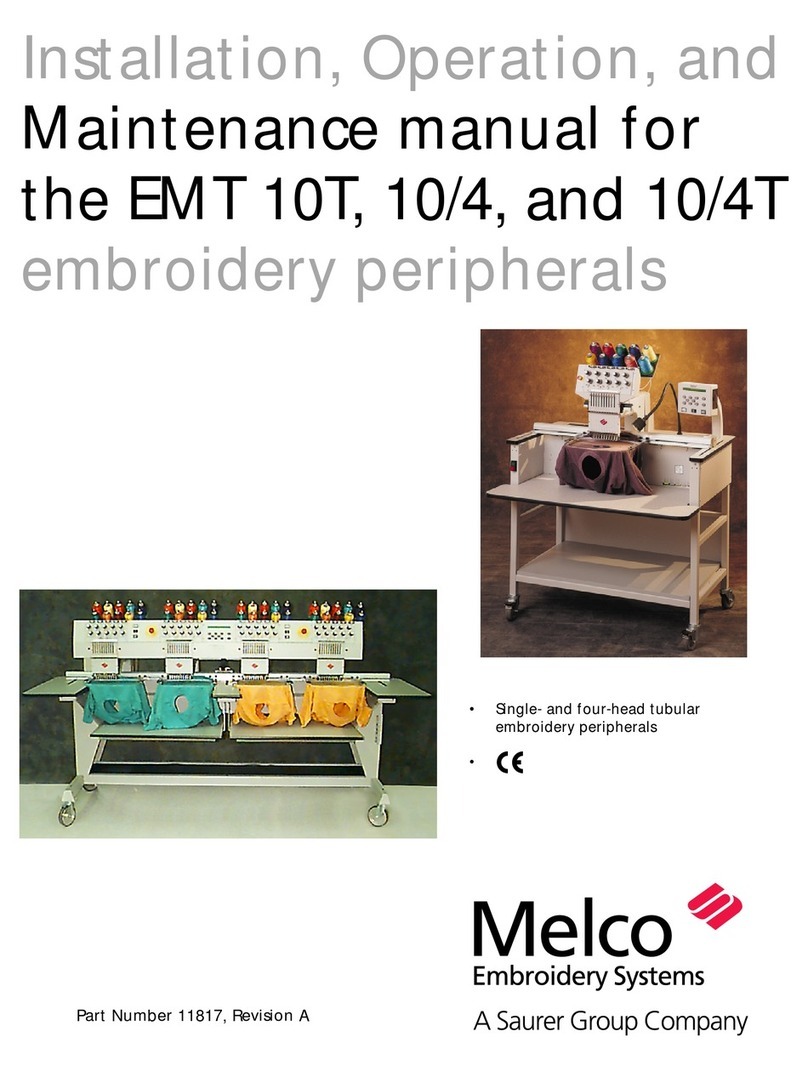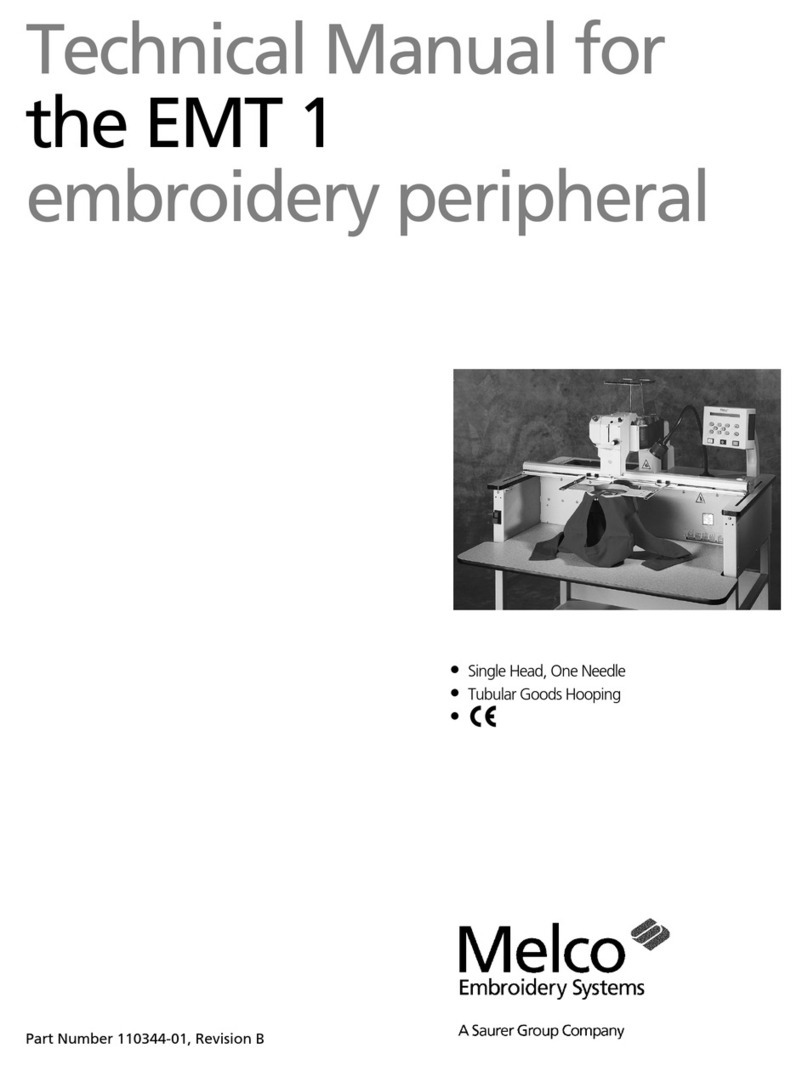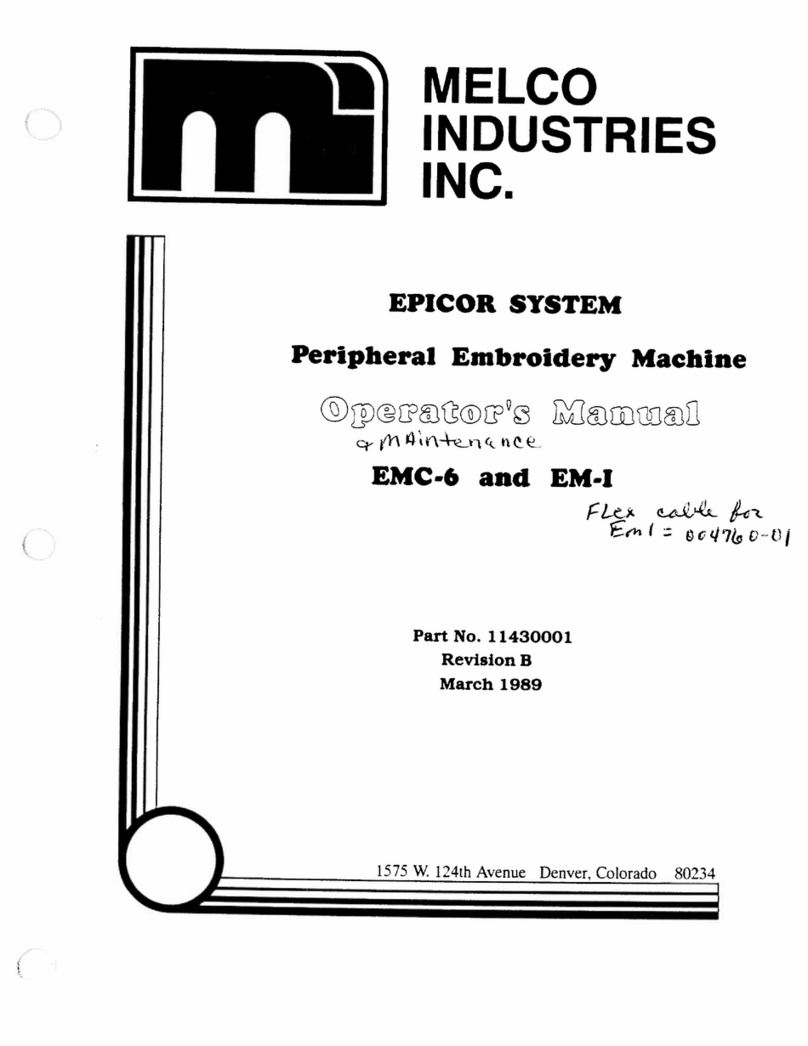Melco Bravo User manual

Technical Manual
Rev 082115

2 of 271
Contents
Copyright Notice 9
About This Manual 10
Scope of Manual 11
Standard Conventions and Denition of Terms 12
Regulatory Notices 13
Best Maintenance Repair Practices 14
Maintenance Philosophy: 14
Grounding and Static Electricity 17
Machine Orientation 19
Safety Issues 20
Warranty Considerations 21
Explanation of Machine Symbols 22
Keypad Operations 23
Keypad Buttons 26
Trace Button 26
Arrow Up Key (Y-Axis Back) 26
Color Change/Needle Case 26
Arrow Left Key (X-Axis Left) 26
Arrow Right Key (X-Axis Left) 27
Center Key 27
Adjustment Key 27
Arrow Down Key (Y-Axis Forward) 27
Hoop Key 28
Step Back Key 28
Step Forward Key 28
Laser Key 28
Start Button 28
Stop Button 29
Emergency Stop Button 29
LED Indicator 30
Specications 31
Technical Specications 33
Torque Specications 34
Table of Contents

3 of 271
Software Maintenance Menus 36
Special Tools and Fixtures 37
General Maintenance 38
Cleaning 38
Lubrication Schedule and Specications 40
Maintenance Schedule 40
Daily Maintenance 42
Weekly Maintenance 43
Monthly Maintenance 45
Quarterly Maintenance 51
Thread Cutter Blade Replacement 61
Centering The Needle Plate 62
Head Up Position Adjustment 63
Mechanical Head-Up Position 63
Adjusting Head-Up (Z-Home) Position: 64
Hook Timing Inspection/Adjustment 65
Rotational Hook Timing Inspection Procedure 65
Needle To Hook Gap Inspection Procedure 67
Adjustment Procedure 67
Thread Clamp Replacement 71
Thread Clamp PCB Replacement 72
Thread Clamp Harness Replacement 72
Laser Light - Adjustment 74
Needle Depth 76
Setting the Needle Depth by Eye 76
Presser Foot Height 77
X/Y Home Adjustment 78
Home Adjustment Procedures: 78
X-Cable Tension 81
Determining if an X-Cable is Set to Required Specications 81
Adjusting an X-Cable that is Tensioned Outside the Required Specications 82
Y-Axis Timing Belt Tensioning 84
Y-Axis Belt Tension Inspection 84
Y-Axis Belt Tension Adjustment 85
When Belt Tensions are Correct 85
Y-Motor Timing Belt Tensioning 86
Inspection and Adjustment 86
Table of Contents

4 of 271
Z-TIMING: Bottom Center & Head-Up 87
Bottom Center (Z Timing) 87
Z-Drive Belt Tensioning 92
Inspection and Adjustment 92
Z-Home Adjustment 94
Procedure to Identify the Closest Needle 95
Needle Case Calibration 98
Fine calibration procedure: 98
Rough Calibration Process: 99
Rotary Hook Support Adjustment 101
Inspection Procedure 101
Adjustment Procedure 103
Color Change, Take-Up, Feeder Housing Assembly 105
Replacement Procedure for Entire Color Change/Take-Up/Feeder Assembly: 105
Color Change Linear Actuator Replacement 107
Replacement Procedures: 107
Thread Feeder Gear Replacement 110
Replacement Procedures: 110
Thread Feeder Optical Sensor PCB Replacement 112
Replacement Procedure: 112
Thread Feeder Radial Bearing Replacement 113
Replacement Procedures: 113
Thread Feeder Stepper Motor Assembly 114
Replacement Procedure: 114
Laser Pointer Assembly 116
Replacing the laser assembly: 116
LED Cluster PCB Replacement 118
Presser Foot Assembly Replacement 119
Reciprocator 122
Replacement Procedure 122
Take-Up Lever Cam Replacement 124
Replacement Procedure 124
Z-Drive Repair and Adjustment 127
Z-Drive Belt Replacement and Tensioning 127
Z-Home Sensor PCB Replacement 129
Table of Contents

5 of 271
Z-Belt Idler Assembly Replacement 131
Z-Motor Assembly 132
Clearing Thread from Thread Feeder Roller 135
Color Change Spindle Mounting Bracket Replacement 137
Grabber Blade Replacement 139
Needle Case Removal 142
Needlecase Installation 144
Grabber Stepper Motor Replacement 146
Take Up Lever Replacement 147
Thread Feeder (replacement and adjustment) 149
Thread Sensor Assembly Replacement 152
Bobbin Shaft Overhaul 154
Rotary Hook Replacement 156
Main PCB 158
Power Input Assembly Replacement 160
Power Input Assembly Removal: 160
Power Input Assembly Component Replacement: 161
Power Input Assembly Installation: 166
User Interface Assembly Replacement 167
Harnesses 170
Color Change Motor Harness 171
Ethernet Harness 174
Grabber/Threadfeed Motor Harness 176
Grabber/Threadfeed/CC Home Harness 179
Laser Harness 182
LED Cluster Harness 184
Replacement Procedures: 184
Thread Break Harness 188
Z Home Harness 191
Table of Contents

6 of 271
User Interface Harness 193
X/Y Home Harness 195
Bearing Block Assemblies 197
X-Beam Assembly 199
X-Carriage Assembly 201
X-Drive Cable Removal 203
X-Drive Cable Installation 205
X-Drive Motor Replacement 209
X-Home Optical Switch Assembly Replacement 212
X/Y Home PCB Replacement 214
Y-Drive Belt Replacement 216
Y-Motor Assembly 218
Troubleshooting 220
Grabber Function Test 221
Final Functional Tests 223
Optical Sensors Test 225
Power Supply Test 226
Servo Motor Resistance Test 229
Stepper Motor Resistance Test 230
Servo Motor Resistance Test 231
Troubleshooting Stepper Motors 232
Table of Contents

7 of 271
Test Designs 235
Thread Tension Test 236
Belt Tension Test 237
Long Stitch Test 237
Looping Test 237
Orientation Test 238
Registration Test 238
Small Alphabet Test 238
Thread Break Sensor Test 239
Thread Break Test 239
Trimmer Test 240
Electrical Failures 241
AC Power Failure 241
Color Change Failures 241
LED Cluster Assembly Failures 242
Machine Initialization Failure 242
Mechanical Failures 244
False Thread Breaks 244
Loose/Looping Stitches 244
Needle Breaks 244
Skipped Stitches 245
Thread Breaks 246
Miss-Starts 250
Cap Frame Issues 250
Miscellaneous Problems 251
X-Axis Failures 252
Y-Axis Failures 253
Z-Axis Failures 254
Software Error Messages 255
DSP Command Errors 256
Can’t Initialize Stepper Motors 256
No Trace Data 256
XY Home Not Set 256
Goto Func Error 257
Hoop Center Error 257
Stepper Motor Time Out and Index Errors 257
E-Stop Engaged 258
Servo Motor Errors (Move Time Out, Tracking, and Over Current Errors) 260
Table of Contents

8 of 271
Critical Measurements 262
Introduction 262
Needle Drive Stud to Reciprocator Fit 263
Hook Timing 263
Upper Arm to Lower Bed Alignment 263
Needle to Hook Gap 264
Hook to Rotary Support Gap 264
Take-Up Lever Stroke 264
Take-Up Lever Fit to Shaft 265
Take-Up Lever Endplay 265
Cam Follower Preload 265
Pull Force on Take-Up Lever 266
Color Change Lead Screw 266
Color Change Housing Location 267
Bobbin Tension 267
Presser Foot Adjustment at Bottom Dead Center 268
Thread Feed Forward 200 269
Needles 269
Thread Clean Thread Path 270
Z-Belt Tension 270
X-Cable Tension 271
Y-Axis Timing Belt Tension 271
Proper Lubrication of Moving Parts 271
Table of Contents

9 of 271
Copyright Notice
© Copyright Melco, 2014
ALL RIGHTS RESERVED. No part of this publication may be reproduced, stored in a retrieval system, or
transmitted in any form or by any means (electronic, mechanical, photocopying, recording or otherwise)
without prior written approval from the author. The author reserves the right to revise this publication
and to make changes in it at any time without obligation of the author to notify any person or organiza-
tion of such revisions or changes.
All precautions have been taken to avoid errors or misrepresentations of facts, equipment, or products.
However, the manufacturer does not assume any liability to any party for loss or damage caused by errors
or omissions.
The machine technology is protected by - but not limited to - the following patents:
• U.S. 4,955,305
• U.S. 6,823,807
• U.S. 5,603,462
• U.S. 5,832,853
• U.S. 6,445,970 B1
• U.S. 6,732,668 B2
• U.S. 6,729,255
• U.S. 6,871,605
• U.S. D 474,785 S
• U.S. 6,736,077 B2
• CH 693569 A5
• EP 0 666 351 B1
• more patents pending
Table of Contents

10 of 271
About This Manual
This manual contains instructions on repairs and adjustments to the embroidery machine, in addition to
other technical information.
If you do not fully understand any information in this manual, you are advised to contact your local au-
thorized technical support provider for assistance.
Table of Contents

11 of 271
Scope of Manual
This technical manual is a guide to performing repairs and adjustments that go beyond routine operator
maintenance.
Although these procedures are best understood and performed by professional service technicians in
conjunction with specic factory technical training, much of the information in this manual is a useful
reference for others who might possess appropriate technical aptitude and skills.
•
Note: This manual is written for individuals with adequate knowledge, Melco certied training
or equivalent and experience in the use of tools required. No attempt is made to explain how
to use tools required to make repairs to the machine other than graphical depictions within the
procedures involved.
This technical manual species that certain functions are to be performed only by authorized service tech-
nicians. This is because specialized training and/or special tools or xtures are required in order to per-
form the function correctly. Performing repairs to the machine may result in damaged components, poor
machine performance, and potential injury to the technician or operator.
If you do not fully understand any information in this manual, contact technical support for assistance
before performing the procedure. The technical support staff are professional service technicians trained
on this equipment. They have acquired technical expertise through experience and technical training.
Additionally, certied equipment technicians routinely receive up to date servicing information to further
enhance their product knowledge.
This technical manual is presented in six sections:
1. Introduction to the manual and various service requirements
2. General information and specications containing all of the engineering settings and specications
you need to know when adjusting the machine
3. Lubrication schedules and procedures
4. Service and repair - detailed instructions to service and repair the machine
5. Options - maintenance and repair of optional equipment
6. Troubleshooting - a troubleshooting guide for problems commonly encountered with the machine.
Table of Contents

12 of 271
Standard Conventions and Denition of Terms
Throughout this manual abbreviations and specic terms may be used. When abbreviations or techni-
cal terms are used, they are dened through the use of pop-up hot spots, which opens a dialog box to
explain their meaning. Hot spot text is green and underlined. To access a pop-up hot spot simply click the
underlined word to read its explanation.
Certain procedures in the manual require actions such as pressing a certain key, or typing some letters on
the computer keyboard. The following is a list of some of the more commonly used conventions found in
this manual:
• To indicate a key on the computer keyboard, the key in question is enclosed in brackets, for exam-
ple: Press the [Enter] key to initiate the application.
• A key on the interface keyboard is represented by a picture of that key.
Attention Styles:
Occasionally in the manual, special attention is required. In these situations, certain images and text styles
are used to attract your attention to a particular message. The following styles are used to denote certain
types of messages.
•
WARNING!! Situations which may result in personal injury if not performed correctly.
•
CAUTION!! Situations that might result in damage to equipment or property but is not likely to
result in personal injury.
•
IMPORTANT: Situations critical to correct machine operation that is not likely to result in damage
to the machine or personal injury.
•
NOTE: Important information that is signicant, but not likely to result in interference to correct
machine operation.
•
TIP: Helpful information that might make a procedure easier or more efcient.
When a reference to a part description is in bold type, that reference is the actual part description as
listed in the machine parts manual. The parts manuals are unique for each machine depending on serial
number and date of build. For part numbers, pictures, and assembly diagrams, refer to the parts manual
issued for that particular machine.
Table of Contents

13 of 271
Regulatory Notices
(U.S.) The FCC (Federal Communications Commission) mandates that if a user makes changes or modi-
cations to the machine not expressly approved by the manufacturer, the user’s authority to operate the
machine may be voided.
Table of Contents

14 of 271
Best Maintenance Repair Practices
The procedures presented in this manual are to be considered best maintenance repair practices. These
procedures are intended to optimize the performance and durability of your machine. Best maintenance
repair practices are to be performed using the correct tools and xtures while adhering to all safety pre-
cautions appropriate for each job.
•
WARNING!! Personal injury may result if proper precautions are not observed. Remove rings,
watches, and any other metallic objects from hands and wrists before servicing the machine.
Remove metallic articles from shirt pockets to prevent them from falling into the machine. Do
not allow loose clothing or long hair contact moving parts of the machine. Under certain con-
ditions of machine failure, the moving parts of the machine may not be controllable by normal
means. At these times, the machine may operate without notice.
•
CAUTION!! Use extreme care not to drop metallic objects, tools, or other conductive material on
the main Printed Circuit Board (PCB) when you have the base cover removed. If you drop such
objects on the main PCB, it can severely damage the electronics which will be very expensive to
repair.
Maintenance Philosophy:
The maintenance philosophy used in this manual is to isolate potential problems within the system to the
smallest practical replacement assembly. Therefore, components are typically not repaired, but rather, a
circuit board or mechanical subassembly may be replaced.
In the process of isolating problems in the machine, the person performing the troubleshooting must also
practice good troubleshooting techniques. Good troubleshooting techniques include, but are not limited
to, guarding against static electricity that can result in further damage to machine components, and only
replacing one part at a time to enable identication of the defective part after the machine is repaired.
•
WARNING!! Failure to practice Best Maintenance Repair Practices may result in injury to person-
nel performing the work and/or damage to the equipment. The warranty is exclusive of, and
may be VOID if poor maintenance practices have caused damage to the equipment.
Dust:
As with any electronics, the worst source for contamination for the PCBs and the Control PCB is dust.
Although great care has been made during the design of the electronics in the machine, dust accumula-
tion may cause failure of the machine if it is allowed to accumulate.
•
CAUTION!! DO NOT use solvents of any type on the printed circuit boards (PCBs) or sensors.
Solvents will damage the electronic components. Use only compressed air to clean these items.
Table of Contents

15 of 271
Using compressed air, blow the dust away from sensors and off the PCB’s in the machine. In addition,
minimize dust accumulation cleaned on all exposed surfaces. Excessive dust will reduce the useful life
span of the machine.
Sensors should be cleaned with dry, compressed air during each of the lubrication cycles. Dust accumula-
tion in the base around the control PCB should be blown out every month or whenever the base cover is
removed for any type of maintenance.
Liquid Cleaning Compounds:
Never spray liquid cleaning compounds directly onto the machine, especially if it is turned on or connect-
ed to an electrical supply outlet. Always spray cleaning compounds onto a rag and wipe the machine
clean. Liquid cleaners can, if sprayed directly on the machine, get onto electrical components and short
them out. Optical sensors are very sensitive and may be damaged by liquid cleaning compounds.
Obstructions:
Obstructions of machine movements can cause severe damage. Obstructions include things like fabric
getting caught in the gears, loose hardware left inside the machine, thread accumulation around the
grabber blade, Velcro, and anything that hinders the machine’s moving parts. It is very important to clear
obstructions from any subsystem immediately before damage or excessive wear occurs.
Use Proper Parts For The Job
It is very important that you use the proper parts for the job, especially needles. Refer to the Operator
Manual for information on needle selection. Using the wrong needle will increase the frequency of frays
and thread breaks and will decrease performance of the machine.
Avoid using substandard substitute parts on the machine. Always use manufacturer distributed parts or
better to ensure superior quality output of your machine. When considering buying substitute parts, i.e.,
hardware, it is strongly recommended that you consult Technical Support and obtain the specications to
ensure that you get the equivalent grade or better parts.
Use The Correct Tools When Making Repairs
Always use the correct tools when making repairs or performing maintenance on the machine. No at-
tempt has been made in this Manual to explain what tools to use. It is assumed that the person who
makes repairs or performs maintenance on the machine has the proper technical aptitude and training to
allow them to do so. Using tools incorrectly or using the wrong tools can cause damage to the machine
and result in personal injury.
The use of poor quality tools such as multimeters and mechanical measuring devices can produce unpre-
dictable and often unsatisfactory results. Always purchase tools for repair or maintenance on the machine
that are of standard design and professional quality. You may if desired, consult Technical Support for
assistance in recommending such tools as multimeters and measuring devices before you purchase them.
Table of Contents

16 of 271
Drive Belt Tensions:
•
CAUTION! Damage to the machine may result if belt tensions are improperly adjusted. All drive
belts require special procedures and tools for setting the proper tensions. If the tension adjust-
ments are made without using the proper procedures and tools (and without training in some
cases), poor performance, excessive wear, damaged components, personal injury, and voided
warranty may result.
Scheduled Maintenance:
Scheduled maintenance is lubrication, cleaning, measurements, and inspections that are specied on a
periodic schedule.
Scheduled maintenance is prescribed in the operator manual for the machine. Failure to perform sched-
uled maintenance will result in poor performance and eventual failure of the machine. In addition, failure
to perform the maintenance prescribed in the operator manual can affect warranty protections.
Lubrication:
Lubrication should be done whenever a part is replaced or repaired and as prescribed according to the
Lubrication Specications. When applying lubricants to any parts, use only the approved lubricants and
application methods specied in the Lubrication Specications.
•
CAUTION! Damage to the machine will result if inadequate or excessive lubrication is applied
to machine parts. Failure to adhere to lubrication specications will result in premature wear,
poor performance, and potential warranty issues.
Torque Measurements:
Apply proper torque to all screws, bolts, and nuts or similar parts used in the machine. Torque speci-
cations are provided for a reason. They have been developed from years of experience with the parts
involved. Avoid guessing at the torque applied to a part and measure it, especially where measurement is
specied.
•
CAUTION!! Inadequate torque can result in premature failure of the part involved, usually
causing it to come loose. Excessive torque usually results in stress to the part that will not al-
ways be detectable. The part can fail later during machine operation and can cause catastroph-
ic machine failure.
Table of Contents

17 of 271
Grounding and Static Electricity
•
WARNING!! It is very important that the power cord is plugged into a properly wired electri-
cal outlet. Failure to have a properly wired outlet may result in damage to the equipment and
personal injury. It is recommended that a licensed electrician be consulted to ensure that the
electrical outlet is properly wired and grounded. If a properly wired electrical outlet is not used
for the source supply voltage to the system, electrical failures may result.
Static Electricity:
As with all computerized equipment, your machine is sensitive to static electricity. Any time work is
performed inside covered areas of the embroidery machine, the person performing the work must use
a static grounding strap or take adequate steps to dissipate static build-up prior to touching electronic
components.
•
WARNING!! Failure to use a grounding strap, or failure to practice other good maintenance/
repair techniques may cause damage to the machine and possible personal injury.
•
CAUTION!! Unless otherwise specied within these procedures, DO NOT disconnect the
electrical supply input cord from the machine or the electrical input source outlet. Doing so will
remove the ground connection needed to dissipate the electrical static build-up prior to work-
ing on the internal components in the machine. Always make contact with the exterior metal
portion of the machine for about one minute to dissipate any electrical static build-up in your
body before touching any electronic component of the machine, especially the main board.
Grounding Strap Use:
A grounding strap should be connected properly to ensure that static charge on the person’s body is neu-
tralized to the chassis ground of the embroidery machine when working in the electronic areas under the
covers. Proper connection is provided at any bare (unpainted) metal surface or any other surface (such as
a ground screw head) that is known to be an earth ground. If a ground strap is not used or is not avail-
able, touch the chassis for about a minute to dissipate any static build-up before you touch any electronic
component inside the machine (with the machine turned off and the power input cord connected to an
electrical outlet).
•
WARNING!! DO NOT attempt to use any grounding strap that is not specically designed for
static use. A “straight-wire” grounding device (one without built-in resistance) will place the
operator in danger of exposure to dangerous voltages. It is recommended that the static strap
be checked during daily use for proper resistance protection.
Table of Contents

18 of 271
•
CAUTION !! Use extreme care not to damage the cable and protective coating during assem-
bly. If the protective coating is damaged, the cable will wear out very fast impacting the quality
of the sew outs.
Table of Contents

19 of 271
Machine Orientation
The references in the manual to certain sections of the machine are oriented as if you were facing the
front of the machine as shown below. Example: The “left” arm cover is on the left side of the machine
when you face it from the front, but is on the right side if you face it from the rear. The part however, is
called the “left” arm cover since it is installed on the left side, oriented as you face the machine from the
front.
Left Side Right Side
The left and right sides of the machine are oriented just as if you were facing it from the front side of the
machine directly.
The rear of the machine refers to the entire back side of the machine.
The front part of the machine refers to the entire front section of the machine.
The upper arm assembly, lower arm assembly, needlecase, user interface, and thread tree refer to the
entire individual assembly and associated components.
Table of Contents

20 of 271
Safety Issues
Voltages
•
WARNING!! Lethal voltages exist inside the power supply unit, at the back side of the electrical
supply input connector, and in the wires between the two. If you plan to do any work with any
of these components, turn the power switch off and disconnect the electrical input supply cord
from the machine.
•
WARNING!! DO NOT disassemble the power supply unit. It contains no customer or eld ser-
viceable parts. The internal components in the power supply unit may contain dangerous volt-
ages even when the power is disconnected. Disassembling the power supply can cause severe
injury resulting from electrical shock, and may void the warranty.
•
WARNING!! DO NOT operate the machine with the lower rear cover removed, except when
indicated by the instructions in this manual. Operating the machine without the covers creates
a risk of severe electrical related injury.
Hazardous Material Notices:
•
WARNING!! The lubricants specied in this Manual contain known carcinogens. Do not allow
lubricants to come into contact with your eyes, mouth, or nose. Always wash your hands thor-
oughly after performing lubrication procedures.
•
WARNING!! When using solvents to clean components in the machine, always ensure adequate
ventilation. Allow all solvents to completely evaporate before turning the machine back on to
prevent shorting out electrical components. Vapors from most solvents are both toxic and am-
mable. Dispose of rags soaked with solvent properly.
Moving Parts:
•
WARNING!! Do not operate the machine without the covers being installed. Moving parts can
cause crushing and pinching injuries. In addition, fabric and other materials can get caught in
the moving belts and gears and damage the machine.
•
WARNING!! Do not attempt to pull on or trim threads near moving needles. This can result in
painful injury.
Table of Contents
Table of contents
Other Melco Sewing Machine manuals
